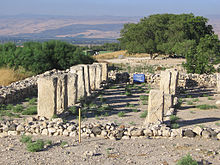תל חצור | |
 House of Pillars at Hazor | |
| Location | Tell el-Qedah, Israel |
|---|---|
| Region | Upper Galilee |
| Coordinates | 33°1′0″N 35°34′1″E / 33.01667°N 35.56694°E |
| Type | Settlement |
| History | |
| Abandoned | 732 BC |
| Official name | Biblical Tells – Megiddo, Hazor, Beer Sheba |
| Type | Cultural |
| Criteria | ii, iii, iv, vi |
| Designated | 2005 (29th session) |
| Reference no. | 1108 |
| Region | Asia-Pacific |
Tel Hazor (Hebrew: תל חצור), also Chatsôr (Hebrew: חָצוֹר), translated in LXX as Hasōr (Ancient Greek: Άσώρ),[1][2] named in Arabic Tell Waqqas / Tell Qedah el-Gul[3] (Arabic: تل القدح, romanized: Tell el-Qedah), is an archaeological tell at the site of ancient Hazor, located in Israel, Upper Galilee, north of the Sea of Galilee, in the northern Korazim Plateau. From the Middle Bronze Age (around 1750 BCE) to the Iron Age (ninth century BCE), Hazor was the largest fortified city in the region and one of the most important in the Fertile Crescent. It maintained commercial ties with Babylon and Syria, and imported large quantities of tin for the bronze industry. In the Book of Joshua, Hazor is described as "the head of all those kingdoms" (Josh. 11:10). Though scholars largely do not consider the Book of Joshua to be historically accurate,[4] archaeological excavations have emphasized the city's importance.
The Hazor expedition headed by Yigal Yadin in the mid-1950s was the most important dig undertaken by Israel in its early years of statehood. Tel Hazor is the largest archaeological site in northern Israel, featuring an upper tell of 30 acres and a lower city of more than 175 acres.[5]
In 2005, the remains of Hazor were designated a World Heritage Site by UNESCO as part of the Biblical Tels—Megiddo, Hazor, Beer Sheba.
- ^ Cite error: The named reference
Gauthier24was invoked but never defined (see the help page). - ^ Cite error: The named reference
Budge1021was invoked but never defined (see the help page). - ^ Shalev, Yiftah; Bar, Shay (2017). "An 8th Century B.C.E. Israelite Administrative Centre at Tell el-Asawir/Tel 'Esur". Zeitschrift des Deutschen Palästina-Vereins. 133 (2). Harrassowitz: 123–144. Retrieved 12 July 2021.
- ^ Killebrew, Ann E., (2005). Biblical Peoples and Ethnicity: An Archaeological Study of Egyptians, Canaanites, and Early Israel, 1300-1100 B.C.E., Society of Biblical Literature, p. 152: "Almost without exception, scholars agree that the account in Joshua holds little historical value vis-à-vis early Israel and most likely reflects much later historical times."
- ^ "Scorched Wheat May Provide Answers on the Destruction of Canaanite Tel Hazor - Biblical Archaeology Society". biblicalarchaeology.org. 2012-07-24. Retrieved 2015-09-03.


